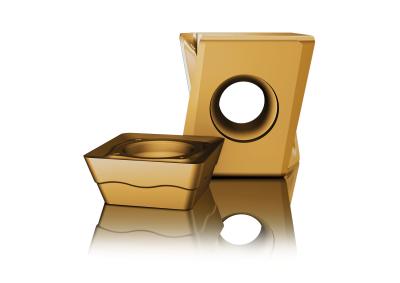
Walter says it has unveiled a technology that promises to dramatically improve machining effectiveness. Called Tiger·tec Gold, it is the latest iteration of Walter’s successful line of Tiger·tec and Tiger·tec Silver coatings.
Tiger·tec Gold with the WKP35G milling grade and its special titanium aluminum nitride (TiAlN) coating makes Walter one of the first companies to employ this performance enhancing coating technology. Compared with the CVD aluminum oxide-coated grades currently in use, the new Tiger·tec Gold coating boasts significantly improved properties, resulting in longer tool life, increased productivity and greater process reliability. This is partially due to the innovative, special "ultralow pressure” (ULP-CVD) coating process that Walter employs.
Walter has tested the new Tiger·tec Gold coating on numerous steel and cast iron applications and recorded markedly improved properties compared with other coatings: These include considerably higher wear resistance on the flank faces, reduced formation of thermal cracks, greater resistance to plastic deformation and considerably longer tool life—often by up to 75 percent. In addition, the gold-colored surface layer also facilitates wear detection.
Contact Details
Related Glossary Terms
- chemical vapor deposition ( CVD)
chemical vapor deposition ( CVD)
High-temperature (1,000° C or higher), atmosphere-controlled process in which a chemical reaction is induced for the purpose of depositing a coating 2µm to 12µm thick on a tool’s surface. See coated tools; PVD, physical vapor deposition.
- gang cutting ( milling)
gang cutting ( milling)
Machining with several cutters mounted on a single arbor, generally for simultaneous cutting.
- milling
milling
Machining operation in which metal or other material is removed by applying power to a rotating cutter. In vertical milling, the cutting tool is mounted vertically on the spindle. In horizontal milling, the cutting tool is mounted horizontally, either directly on the spindle or on an arbor. Horizontal milling is further broken down into conventional milling, where the cutter rotates opposite the direction of feed, or “up” into the workpiece; and climb milling, where the cutter rotates in the direction of feed, or “down” into the workpiece. Milling operations include plane or surface milling, endmilling, facemilling, angle milling, form milling and profiling.
- plastic deformation
plastic deformation
Permanent (inelastic) distortion of metals under applied stresses that strain the material beyond its elastic limit.
- titanium aluminum nitride ( TiAlN)
titanium aluminum nitride ( TiAlN)
Often used as a tool coating. AlTiN indicates the aluminum content is greater than the titanium. See coated tools.
- wear resistance
wear resistance
Ability of the tool to withstand stresses that cause it to wear during cutting; an attribute linked to alloy composition, base material, thermal conditions, type of tooling and operation and other variables.

